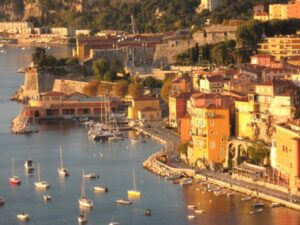French Riviera

The French Riviera is one of the most visited and loved tourist destinations today. It has long been so. For over two hundred years it has attracted men and women visitors who have variously come to benefit from its clement climate, frequent its beaches, paint in the open, write in seclusion, play in its casinos, view its historical sites, savour its cuisine, or just be immersed in its relaxed lifestyle. Stretching from Marseille in the west to Menton on the Italian border, via beautiful Cannes, St. Tropez, Nice, and Monaco, and a coastline of steep cliffs and rocky coves, there is much to discover and enjoy.
I first explored the French Riviera with students from the University of Western Australia on study tours that took us to honey farms, olive mills, pottery ateliers, educational institutes, medieval castles, churches, and abbeys, a perfume and a glass factory, the wild Camargue … and more. The students were enchanted and so was I. On my retirement from academic teaching I was determined to return. Indeed, over the last fifteen years I have visited the region on multiple occasions and each time been struck by its unique cultural and geographical identity: its art, history, religious sites, and stunning scenery; above all, I became fascinated by the literature it has inspired.
The number of visitors to the South truly burgeoned in the nineteenth century as coastal rail transport expanded and the visiting population duly soared. And writers were among its burgeoning foreign clientele. Medical treatises on the region’s therapeutic climate proliferated; guidebooks and travel memoirs extolled its beauty; newspapers reported on the royal and aristocratic winterers who came south in quest of light and sun. But it was the post-First World War, generation, eager to forget and forgo past political hostilities and embrace revised gender and dress codes, that markedly changed the Riviera’s social profile. The age of the spirited flapper, of beachgoers and suffragists, of Coco Chanel fashionistas and jazz players, of class iconoclasts and an artistic avant-garde, changed the Riviera’s social profile. Concomitantly, a new literary industry was born: travel brochures abounded, the postcard from abroad was the modern missive; novelists – consider Ernest Hemingway, Jean Cocteau and Somerset Maugham – came south for writing time, conviviality, or repose. Scott Fitzgerald immortalised it in the fictional Tender is the Night.
Alongside men, women were avid visitors to the South in the nineteenth century which was much popularised by the winter sojourns of Queen Victoria, Empress Elisabeth of Austria and Russian royalty; some came to recuperate from respiratory ailments; many as accompanying daughters or wives, others to fulfil personal goals. But in the early twentieth century and in the midst of the gender and social revolutions following the Great War, newly independent women, capitalising on improved travel opportunities and new lifestyle freedoms, changed the South’s visiting demography. In my book on women writers of the Riviera, 1870–1970, I have explored the experiences of nine women visitors whose professional ambitions and achievements, set down in writings of singular insight and literary power, contributed to the cultural development of the South in ground-breaking ways. Variously writing on art, ballet, cooking, society, nature, and illness in challenging or inspiring Mediterranean locales, they changed the Riviera as much it changed them.